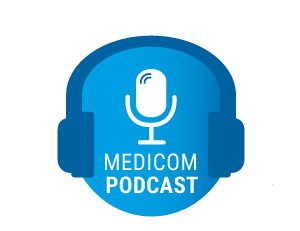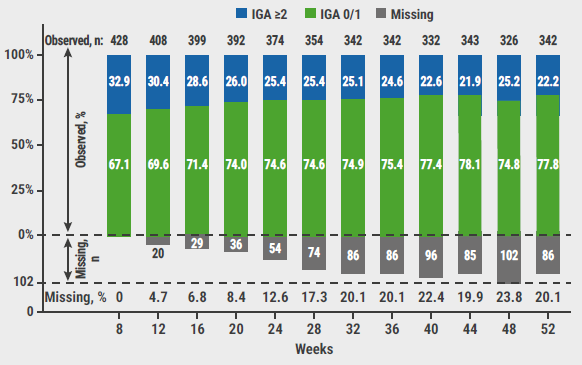In 2022, the FDA approved the phosphodiesterase 4 inhibitor roflumilast as a 0.3% water-based cream for the treatment of plaque psoriasis. The drug is also studied in other indications, such as seborrheic and atopic dermatitis, the latter most recently in the 2 presented phase 3 trials INTEGUMENT-I (NCT04773587) and INTEGUMENT-II (NCT04773600) [1–3].
A total of 1,337 patients were randomised to a vehicle or once-daily roflumilast 0.15% cream use over 4 weeks [1]. Participants had to be at least 6 years old and present with mild or moderate AD. Prof. Lawrence Eichenfield (University of California San Diego, CA, USA) underlined that almost 50% of the participants were paediatric patients between 5‒17 years of age. Around one-third of the participants in both trials presented a vIGA of 3 at baseline, mean Eczema Area and Severity Index (EASI) scores ranged from 9.8 to 10.3, and mean Worst Itch Numeric Rating Scale (WI-NRS) values ranged from 5.9 to 6.2.
At week 4, the proportions of participants achieving the primary endpoint of vIGA of clear or almost clear skin plus a 2-grade amelioration were significantly higher in the roflumilast arms than in the vehicle arms: 32.0% versus 15.5% (P<0.0001) and 28.9% versus 12.0% (P<0.0001) in INTEGEMUNT-I and INTEGEMUNT-II, respectively. Also, the EASI75 results were in favour of roflumilast cream (43.2% vs 22.0% for INTEGUMENT-I and 42.0% vs 19.7% for INTEGUMENT-II), with a significance level of P<0.0001 for both trials.
Since itch is an important symptom of AD, reaching a ≥4-point WI-NRS reduction was also evaluated as a secondary endpoint: in INTEGEMUNT-I, the ratios were 33.6% versus 20.7% at week 4 (P=0.0089) and in INTEGEMUNT-II were 30.2% versus 12.4% (P=0.0014) for roflumilast and vehicle, respectively. Prof. Eichenfield stressed that an itch improvement could be noted within 24 hours after the first application of roflumilast.
The most common treatment-emergent adverse effects were headache, nausea, application site pain, and nasopharyngitis, but none of these events occurred at a rate above 3.5% in the roflumilast groups. Thus, the investigators adjudicated an overall favourable safety and tolerability profile to the active treatment.
- Eichenfield L. Efficacy and safety of roflumilast cream 0.15% in adults and children aged ≥6 with mild to moderate atopic dermatitis in two phase 3 trials (INTEGUMENT-1 and INTEGUMENT-2). S025, AAD Annual Meeting 2023, 17–21 March, New Orleans, USA.
- Thurston Jr AW, et al. Am J Clin Dermatol. 2023;24:315–24.
- Jackson JM, et al. J Am Acad Dermatol. 2022;S0190-9622:03307–2.
Posted on



